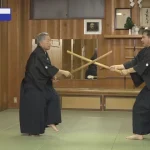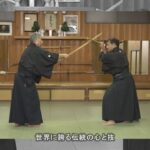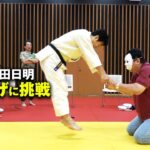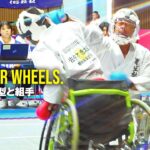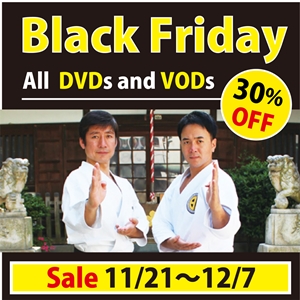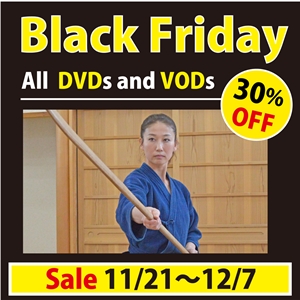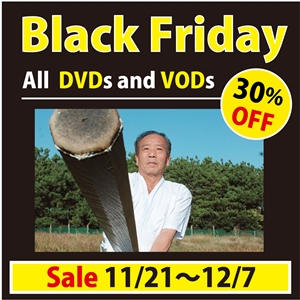Experience “nanba aruki”.
Author: Jessica Gerrity(Instagram/Twitter @jessintokyo)
Hi everyone this is Budo Ambassador Jess. Via internet research and word of mouth I have heard the word nanba aruki ナンバ歩き several times. I wear Japanese style clothing or wafuku 和服 (kimono, hakama, momohiki) and sometimes armour or kacchu 甲冑. I heard that nanba aruki is historically the way that people used to walk when wearing these types of garments. But why? And why dont they walk this way in modern Japan? Today I hope to shed some light on nanba aruki.
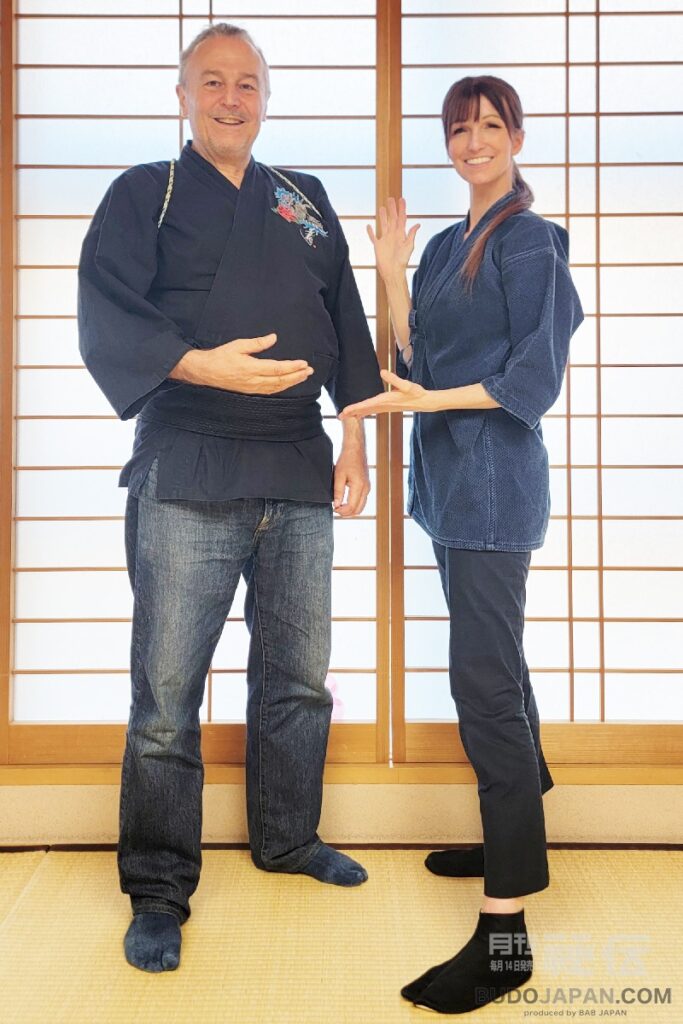
William Reed sensei
When I found out I would be training nanba aruki or nanba walking with William Reed sensei I was very happy. Reed sensei is very well known and highly respected here in Japan as a practitioner of traditional martial and samurai arts. He has lived in Japan since 1973 and is a professor at Yamanashi Gakuin University, where he is currently teaching Japanese arts and Samurai disciplines. Reed sensei is a Master teacher of Nanba Jutsu (Art of Physical Finesse), he also holds the rank of 8th dan in Aikido, 10th dan in Shodo (Brush Calligraphy), 7th dan in Small Brush Calligraphy, and 2nd dan in Iaido.
Reed sensei first heard about nanba walking from his Aikido sensei, Maruyama Koretoshi, founder of Aikido Yuishinkai who mentioned that this was the way that samurai walked. Those words really sparked his interest in nanba walking and as such he has devoted a large part of his life to researching, training and teaching nanba jutsu or the art of physical finesse.
Benefits
In several martial arts such as Kendo and Aikido there are said to be directly applicable benefits and crossover to learning the mindful and fluid movements of nanba walking in one’s training.
In a regular person’s daily life the benefits can be summarised as follows:
*Less stress, twisting and strain on your body resulting in longer lasting stamina.
*A more stable posture with reduced twists in the upper half of your body.
*No wasted energy by the correct application and focus of energy when walking or running
*More power by moving one arm, hip and leg at the same time, like the wooden pole used by sumo wrestlers in training.
*Less strain on your body by climbing steep slopes or stairs in the Namba running style.(1)
History
The facts surrounding the origins and history of nanba walking are quite varied with some sources saying it originated in kabuki (2), others say it came about because of yoroi or Japanese armour (3) and some saying it has its origins in Noh Theatre involving very controlled movements in traditional Japanese clothing (4). I was always of the impression that express messengers used this method of walking in order to travel very long distances without getting tired. The samurai class, with a sword attached at the hip preferred nanba walking to stop the sword from swinging around as they walked (5)
“The movement of Nanba was a natural fit for the Japanese kimono, obi belt, and straw sandals, so Nanba is also a good match for the Martial arts,” William Reed
There are several theories on why Namba Aruki declined in popularity over time. Many suggest that this was most obvious in the Meiji Period when Western military training and marching became popular (opposite hand and foot swing, with body twists). Due perhaps in part also to a Westernization of clothing, furniture and other aspects of the traditional Japanese lifestyle. Instances of walking out and about with a sword, wearing kimono and geta sandals decreased, and nanba may not have been seen as useful or practical anymore, leading to the decline in its usage.(5)
I myself, live in Japan and am someone who wears Japanese garments/kimono, and armour in my everyday life and am also someone who practices various martial arts. I was personally very interested to see how my regular walking style would compare to nanba walking. I hoped to also take away some hints on integrating the nanba techniques and the nanba way of thinking into my daily life and training.
The Training
Our training took place in a washitsu or Japanese style room. The tatami made for a soft and wonderful area to walk and we wore tabi or Japanese style socks on our feet. I noticed Reed sensei wore an obi or a wrapped woven Japanese style belt. Many martial arts make use of an obi at the hips for men and under the belly button for women. It provides support and for me tends to switch on my lower body and the sensations in my lower back and hips which is why I wear one when practicing kyudo and naginata. Sensei was kind enough to lend me one of his obi and we started the training. Reed sensei firstly explained about nanba and the benefits of walking in nanba style, which I have detailed in the paragraphs above.
Shiseiwotadasu: fixing the posture
The first was to gently place ourselves against the wall focussing on our heels, hip lower shoulder and back of our head to get an idea of natural posture. After getting a feel for that, we took half a step away from the wall and tried to maintain that balance within our body. Reed sensei mentioned that the alignment of the back of the head is quite important as it really impacts our posture and gaze.
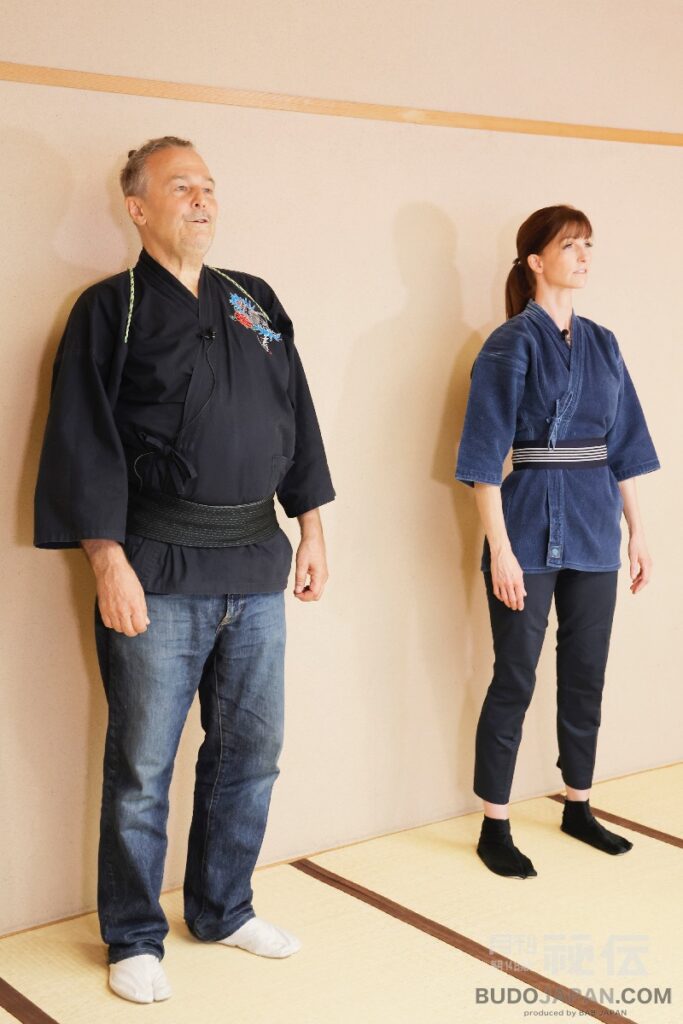
putting our backs against the wall
Many people outside tend to look down as they walk naturally either because they are using their phones as they walk or just out of habit, this tends to decrease their overall field of vision. The concept of eye height and gaze is quite a fascinating and practical one as from a martial arts point of view you ideally want to be able to see if people are approaching you from either side of your field of vision as early as possible to be able to defend yourself.
In addition, raising your gaze up and straight ahead in turn changes the posture and angle of the head (which is one of the heaviest parts of the body) to align it correctly with the shoulders and spine. Over time people notice relief and positive changes in stiff neck and shoulders and tension headaches.
Analysing modern Walking
Due to years of kyudo and some reiho (etiquette) training with Ogasawara-ryu, I have been taught to walk from my hips first. People usually walk with the heel of their foot starting first and the opposite arms swinging, their heads bounce up and down as they walk too. They are used to this way of walking, and don’t really feel the impact of the heel on the hard ground due in part to the advent of modern sport shoes. Reed sensei says “Modern walking looks dynamic, but the body twists and turns, there is a lot of unnecessary movement and loss of power. Force is lost due to unnecessary movement and kicking off the ground.”
Reed sensei showed how he let tanden (found approximately three finger widths down from the belly button in the lower abdominal area) lead as he started his walk. He naturally leaned into tanden and his hips till a point where his balance changed and before he fell forward that was the point his walk started naturally with his feet (starting with either foot is ok) following along naturally. The important point was that the pelvis and hips lead with the feet coming naturally after. Tanden is discussed in most if not all martial arts as a way to control movement, speed and breathing and plays an important role in both kyudo and naginata too.
Komata ni aruku: Taking small steps
In kimono and wafuku or Japanese clothing smaller steps are more natural and are easier to take.Reed sensei mentioned not to raise heels and to try to glide our feet. This resonated with me as a kyudo practitioner however in reality it is actually quite a difficult feat. The balance and control of weight shifting with each step needs to be maintained correctly otherwise our heels will tend to rise off the floor with each step.
Use of the hands
If we aren’t swinging our arms when walking then what should be done with them?
Reed sensei introduced a warming up exercise (age sage warm up) that introduced the correct usage of hands when doing nanba walking. Raising right hand up in a circular motion in coordination with right foot, then left hand up in a circular motion in coordination with left foot on the spot. Sensei likened the image of movement to a piston engine.
Moving on the spot with this warm up felt very dynamic even though the movements were relatively small. It was interesting to try to consciously move both my right hand right foot, and left hand left foot but this was the image that I had via word of mouth about nanba. This exercise serves to move many muscles and ligaments in the pelvis area at once. We slowly increased the speed of the exercise until it felt like we were running on the spot. Once we stopped, Reed sensei noted the same hand and foot should be raised or lowered when you finally come to a stop showing that you have coordinated your movement correctly.
When walking outdoors, hand raising and lowering movements can stand out a little. Reed sensei suggested a smaller movement with fingers only, or middle finger only, drawing the finger in a light reverse circle on the side of our hips as a compliment to our forward movement. Sensei mentioned the reason for a reverse circle with fingers was that the forward circle as we move forward tends to push our arms and shoulders in a forward position leading to quite forward leaning walking where the reverse circle complements and adds a slight feeling of the brakes being applied giving us straighter posture when walking.
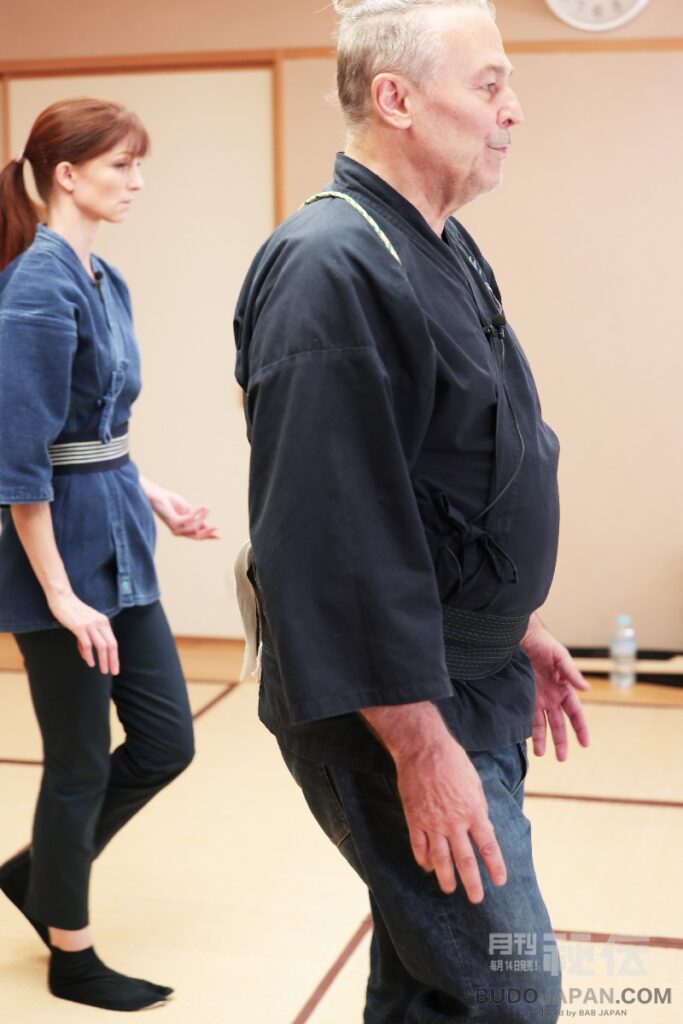
making smaller reverse circles with the hand
Short stick Nanba technique
Reed Sensei showed me an item that he said would help when learning nanba walking. He showed me a light wooden stick about 40cm long. Resting it on my tanden area with my hands on either side of the stick, we make a reverse circle keeping the stick on the tanden area and walking forward. My fingers were out and my thumb was slightly raised during this exercise. When walking the first step is a half circle in reverse, the second step is the rest of the half circle in reverse (feet are pointing straight forward). Using the short stick nanba technique it made it easier to understand the connection between tanden and the reverse circles while moving forward and I found it useful that the equipment could be procured at a hardware store.
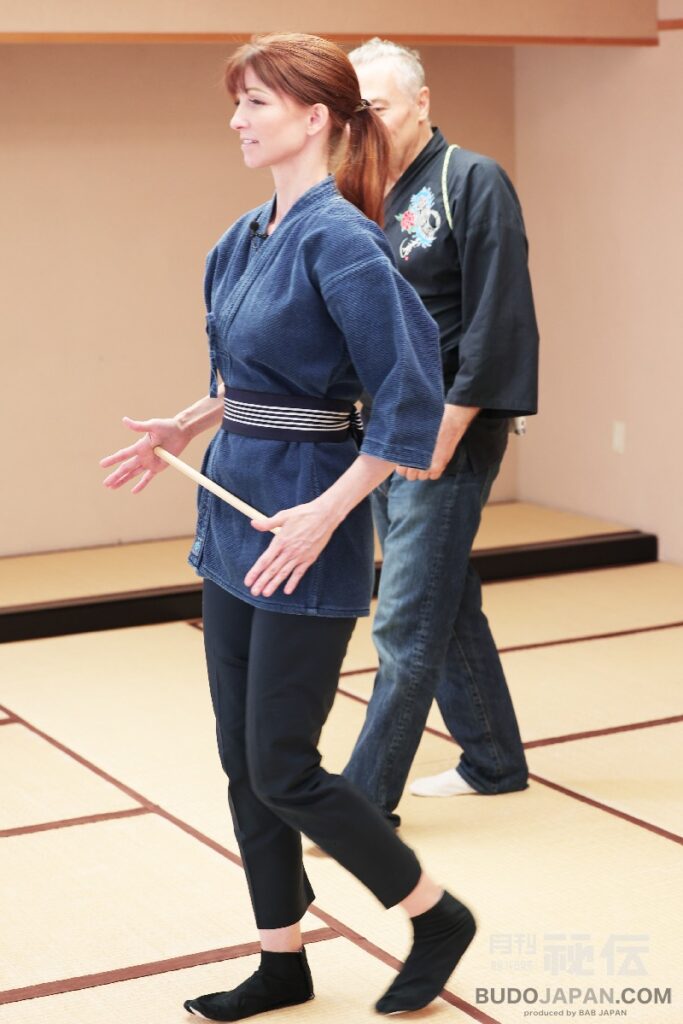
walking with the short stick
Next, Reed sensei observed my walking. I was a little nervous as I am usually quite uncoordinated but I tried my best. I felt I moved unnaturally and sensei suggested that I just focus on movement of my right side as the left side will follow naturally in this exercise. I tried again and noticed my feet were pushing along the tatami similar to the way I walk in kyudo and there was a sound each time I walked (we call this suriash)i. Sensei made no sound when he walked, so I asked about the difference and how he managed to walk so quietly. He mentioned that instead of sliding along the tatami, the feet instead float slightly, gliding on the tatami. Weight is transferred between left and right resulting in a very quiet walk. I had never really thought about or tried this quiet way to walk before and I will be trying again when I get the chance to walk on tatami in the future. I walked suriashi again this time thinking about gliding the foot and moving forwards and to my surprise I made no sound! Sensei mentioned pushing feet along tatami can look a little rough whereas gliding the feet is very controlled and beautiful.
Walking to a whistle or music was also recommended in nanba as it lets you take your focus off the movements and on to the sound which helps movements to become subconscious. Sensei whistled as we walked and I found myself and my conscious thought had gone to figure out which song he was whistling! But the result was a more natural and less stiff walk which was the result I was hoping for. Reed sensei also suggested thinking about being enveloped by our surroundings as we walk towards the place we are headed to. Instead of focusing on the destination, we let it approach us as we walk along. This kind of a shift in mindset (enjoying the journey and all it brings) was my first taste of the nanba way of thinking.
Near to the end of our exercise with the short stick sensei mentioned that over time we make our movements with our hands smaller, with less consciousness as our body becomes used to the movements of nanba till eventually, we can walk without the short stick and use our fingertips.
Synchronized walking
Next sensei talked about matching pace and breathing with people around us. Find tanden and let it lead then whoever moves off first you follow and match their pace and breathing.
In our everyday life though, we usually aren’t consciously trying to match our pace and breathing with the people around us and usually end up doing our own thing. In Japan, keeping the wa 和, or keeping the harmony is important in Japanese society. Small movements and behaviours like keeping pace with someone when walking is both conducive to conversation and keeping that harmony as you walk.
Sassatto step: Nanba quick step
Reed sensei demonstrated bringing right arm and right foot out then left arm and left foot out while bringing right arm and foot in using quite explosive but fluid movements. Initially I found the movement challenging as I tend to overthink in order to make the technique correct. I found shifting my weight as I moved really helped a lot. Sensei demonstrated a very sped up version of this step which looked similar to running on the spot.
He instructed me to hold a tenugui cloth or rectangular cotton cloth and said he would try to take it from me. I knew his hand would reach for the cloth so I held it very tightly and as predicted he couldn’t take it from me. Sensei performed the nanba quick step at a very fast pace. The dancing hands and feet and moving body overwhelmed my senses and I was taken off guard when sensei grabbed the tenugui cloth out of my hands catching me by surprise! My focus had become the movements and the sound of Reed senseis’ feet on the tatami. This resulted in me neglecting to think about the tenugui cloth and as a result it was taken from me.
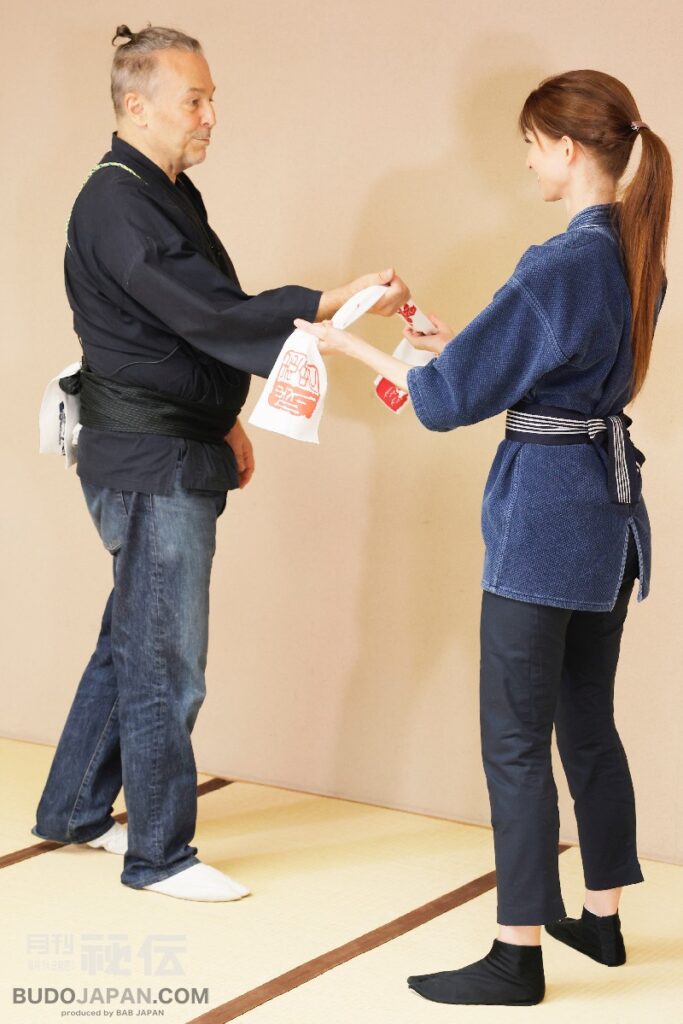
Reed sensei attempts to grab the cloth
Next it was my turn and Reed sensei held the cloth. It was impossible for me to take the cloth from his hands. I tried the quick step moving my hands and feet as fast as I could. At the same time Reed sensei was actually explaining the technique to the camera when I took the tenugui cloth from him quite suddenly when he didn’t expect it. Having Reed sensei slightly distracted made a huge difference in his overall reaction time. When I managed to take the cloth it made us both laugh in surprise. The overall lesson I took away from this exercise was the amazing power of focus and distraction. If you are very still, sudden movements are seen instantly and defense will be taken by the other party. On the other hand if you are busily moving about and make a movement suddenly initially it may not be noticed until too late which is exactly enough time is necessary for an attack to happen.
Breathing in nanba
I was very surprised when Reed sensei mentioned he uses a kyudo rubber bow or gomu yumi in order to control and observe breathing during his nanba training. We use a rubber bow in many different ways during kyudo practice and they are useful in places where the ceilings are low and space is limited.
Reed sensei expelled all his breath then using the rubber bow he raised it up filling his lungs until his arms were raised and his hands were above his head. Then while focussing on tanden and his abdominal area he began to draw the rubber bow expelling his breath in a slow and steady way until reaching fulldraw. In full day or kai, he finished breathing out and reached a stage of pulling the bow opening the chest in fulldraw and had finished breathing. A state of neither inhaling or exhaling, a state of not moving and mu or nothingness. At a certain point he released the bow and it snapped forward, ending the exercise.
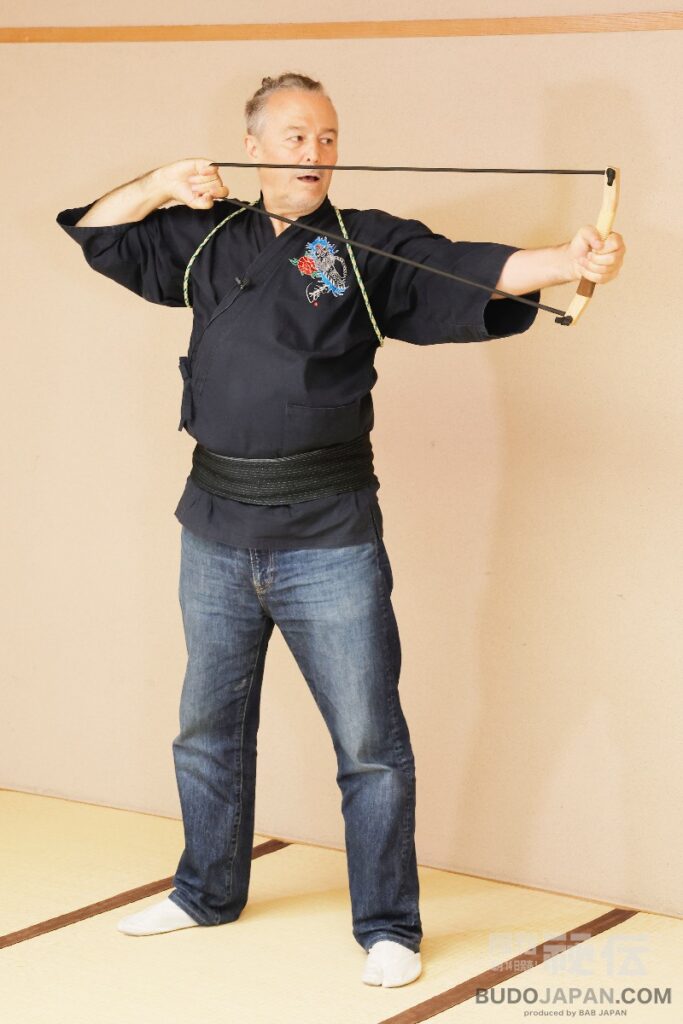
Reed sensei with the rubber Bow in fulldraw
I felt that utilising the rubber bow as a tool to teach and for the body to focus on for breathing training was a very good idea. Deliberate and conscious breathing is something that I most definitely need to think about as it affects my movements in kyudo. More specifically kyudo group and ceremonial shooting (taihai) required matching our breathing as it makes for well timed movements and shooting of which we are graded on during examinations.
I tried the breathing exercise with the rubber bow and I found it very easy to understand the use of controlled breathing however I found it difficult to make deliberate sounds when breathing out. This was in part due to the fact that I usually breathe very silently in my everyday life and practice of kyudo. Despite having trained in martial arts for about 7 years, deliberate and mindful breathing is actually quite a new concept to me.Through the exercise I have been able to really understand the connection to my lower body area and tanden area and feeling the control and stability it provides my body in everyday life and when training arts like kyudo and naginata.
[*Another option for gaining similar movements for this exercise can be achieved by using an exercise band for stretching. Here in Japan the green rubber exercise band from 100 yen shop Daiso provides a similar sensation to the rubber bow,]
Reed sensei talked about sanso no danjiki or conscious and mindful oxygen deprivation for the purposes of muscle growth and stimulation. Our body warms and we may find ourselves sweating as a result of small and concentrated movements like the rubber bow exercise where we fully breathe out and stay that way for several seconds, as long as it is comfortable. “Researchers have long shown that one of the important stimuli for muscle growth is local hypoxia. That is, a reduced amount of oxygen in the muscle itself is one of the factors which stimulates muscle growth.”(6)
Connecting breathing, tanden and stability
Reed sensei continued to discuss and explain the relationship of tanden with total stability of the body. He demonstrated this by getting me to raise the bow again, breathing in the exact same way I had before. During the draw of the bow when I was consciously breathing out he pushed my hip area to see if I would move. Very little movement occurred and I think this was largely in part to my daily kyudo practice which has me using tanden and keeping my lower body very stable otherwise my shooting is affected.
Next, sensei said don’t focus on using tanden (loosen tanden) and just raise the bow and draw it. To be honest this is actually more difficult than you think as I am trained a certain way and to not use tanden, to purposely stop using it was a very strange feeling. My foundation and lower body became very floppy. Again sensei pushed my hip area and this time I was easily pushed to the side. Looking back over the video the difference between using and not using tanden is very visible. We swapped places and I attempted to push sensei while he was drawing the bow. I slipped on the tatami floor and moved myself while he stayed the same in fulldraw with the rubber bow. This exercise really served as a reminder of the power of tanden and how control of the lower body is really interconnected with the upper body.
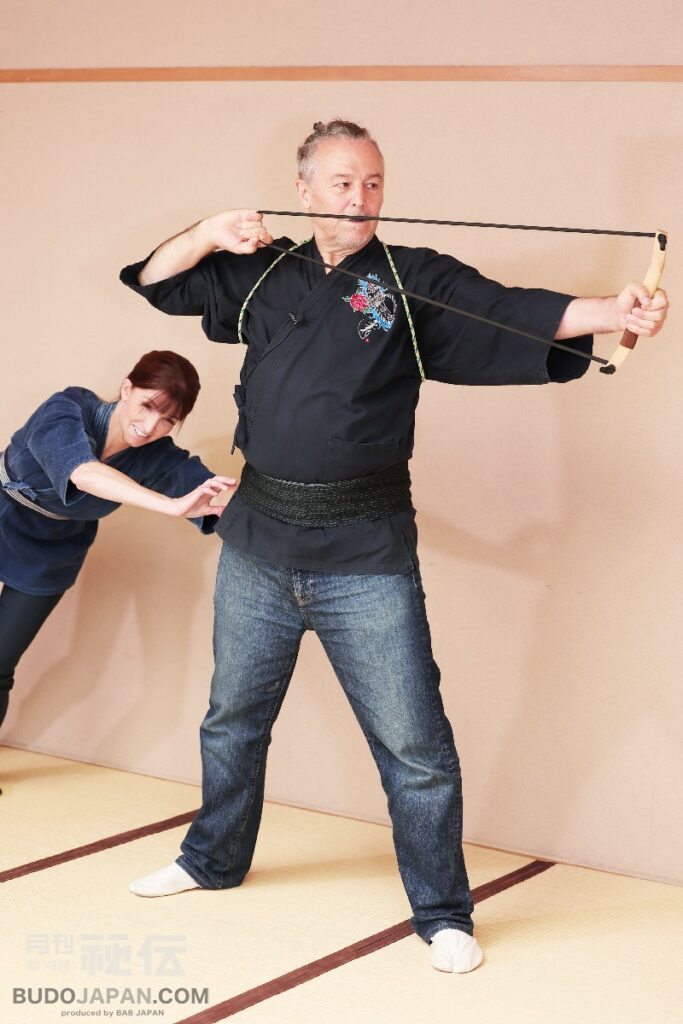
Reed sensei demonstrates the connection between breathing and tanden and stability
Suriashi exercise
With our hands resting on the front of our pelvis we tried suriashi or walking in smaller steps on tatami. As you step our feet lightly glide against each other. Wearing tabi, suriashi was very straightforward and easy to walk. I realised that this may have been due to me practicing different arts like reiho and kyudo. Sensei mentioned that the shape of tabi with the big toe separate helps in the use of inner leg muscles.
Sensei introduced another exercise called yuka wo tsukamu or grabbing onto the floor with your toes. I tried gripping the tatami with my toes to see how it would affect my posture and balance. Sensei pushed me from the side and I didnt move. Next I relaxed my feet and lightly lifted my toes from the tatami and when sensei pushed I was moved sideways very easily.
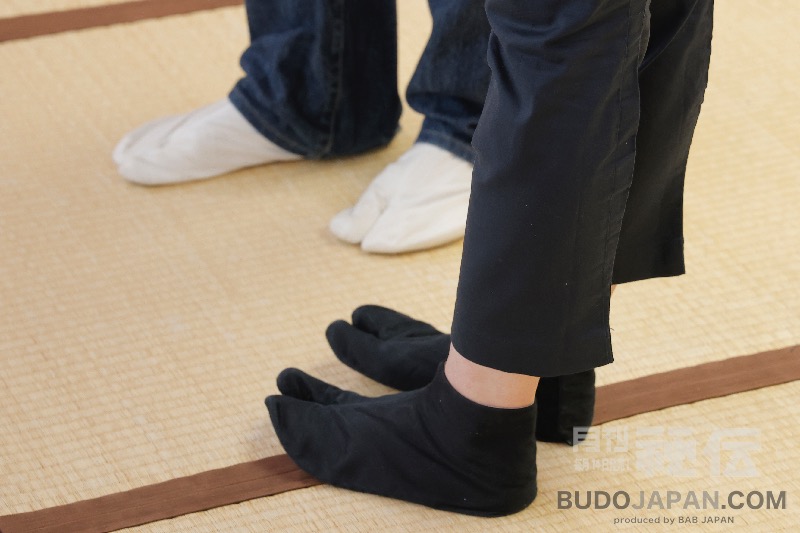
toes lifted lightly off the tatami
He mentioned in the case of the hands it is the little finger that is important as in runs down our arm and side controlling our trunk and tanden however with the feet it in the big toe that tend to control the inner leg muscles, These exercises really showed me mindfulness and conscious use of the body and how breathing really aids to support and control movement. I was surprised to hear that this loosening of tanden had knock-on effects as people age such as issues of incontinence. I hadn’t really thought of this before but it made a lot of sense.3
Lastly, sensei explained that no matter how devoted you are to your art budo or martial art you really only have a couple of hours a day that you are in the dojo training. The out of dojo time is also important too. Even when out of the dojo it’s important not to neglect our tanden and mindful breathing in our everyday life.
This philosophy and way of thinking is very similar to Ogasawara-ryu. Kiyomoto Ogasawara Sensei has said similar words during training too. He says that the proper use of the body, tenouchi or the way we hold objects, breathing, and movement is continued out of the dojo in our everyday lives.
I really like this idea of not separating the use of the body in and out of the dojo. Instead of having to take time to warm up with special exercises, this way of connecting your in and out of dojo movements means your body will always be ready for whatever eventuates.
Conclusions
Training in Nanba walking with Reed sensei was very interesting and I feel quite lucky to have experienced it hands on from such a well known sensei. I was very interested to learn about the history of nanba and in particular why its usage seemed to have become a rarity for the general population of Japan except for application by several areas of specialists in various martial arts. Changes in clothing and lifestyle due to a Western influence deeply affected the way Japanese people moved their body and lived their life.
Nanba walking in this modern era is in resurgence and can be adapted to our modern lifestyle no matter if we wear kimono or not. It has become a way for people to focus their movement, breathing, and walking with more control and balance. Walking with less excessive force and energy leading to reduced stress on both body and mind. I really enjoyed the discussion of correct posture, especially correct head position leading to an overall decrease of shoulder and neck pain. I too find myself walking looking down sometimes and need to remind myself to bring my head up to look far into the distance. I’m excited to try mindful breathing control in the kyudojo and during naginata practice. Breathing controls the force and power of our movements so I hope to connect my body and its movements more, through more mindful breathing.
In my daily martial arts training I am most focussed on technique and the execution of those techniques and kata. However, I have come to realize that even with what looks to be good use of movement and correct technique may not be. When the inner workings of kata and movements are incorrect or the body is underutilized then true correctness of technique is not really ever achieved. When breathing does not match muscle use and movement then something will tend to seem off about that person’s kata. They will lack power and stamina in their chosen discipline. During this nanbajutsu training session I finally made a deep connection between body, breathing, movement and balance.
Read and Watch more about William Reed here
https://budojapan.com/aiki-jujutsu/williamreed20221018/
The Brush is the Sword of the Mind Samurai Shodo
https://budojapan.com/samurai-shodo-series/
Training On demand
https://budojapan.com/samuraiwalk/
References
- https://jref.com/threads/namba-aruki-namba-walk.338393/
- https://kumablog.org/2010/04/
- https://peoplejapan.wordpress.com/2017/08/31/nanba-the-art-of-physical-finesse/
- https://www.tofugu.com/japan/namba-aruki/#:~:text=Namba%20Aruki%20is%20the%20running,Edo%20and%20the%20other%20provinces
- https://bujinkangard.wordpress.com/2013/07/01/namba-aruki-or-how-to-hack-walking-to-be-more-efficient/
- https://altitudecentre.com/research_post/hypoxic-conditions-promote-muscle-growth/
Also of interest
https://core.ac.uk/download/pdf/144415039.pdf






